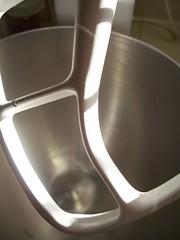When I attended and spoke at
MacGathering a few months ago, I met the representatives from
Slim Devices, who were demonstrating their Squeezebox music player. This is a great device that allows you to link wirelessly to your computer-based music collection (think iTunes, although many other systems are supported) and play this content through your dedicated high-end stereo system. A few weeks later, Slim Devices was kind enough to send me a review unit so I could check it out in my own home media environment.
I often work with clients who are very interested in high-end audio and would love a device like this. I have recommended other, similar products in the past, but I am leaning heavily towards Squeezebox these days for several reasons. The Squeezebox is based on a free, open source, music server that allows programmers to easily fix bugs and extend its capabilities. Currently this shows itself in plugins that allow you to display RSS feeds on the device and provide alternate views, including analog VU meters on the display as it operates.
My experienceSetting up the Squeezebox was simple and straightforward. First, you visit their web site to download the latest version of the SlimServer music server software which runs under Windows, Mac OS and even Linux. While this is uncommon, I felt that having the user download the current version, rather than providing it on a CD is a great idea. Too often, with other products, I am faced with out-of-date software that causes problems with an installation. This download insures that I am getting the most up-to-date and bug-free version at the moment I begin using it.
Next, you install this software which, on the Mac, appears as a Preference Pane in the System Preferences. This program only allows you to turn the server software off and on. To configure the server, you simply use your web browser. The browser interface is easy to use and allows you to set various preferences, such as the name of the Squeezebox (important if you are running more than one) and which system you want to use to manage your music. In my case, I told the Squeezebox that I wanted to use my existing iTunes music library and playlist.
Once the server software was setup, it was time to install the Squeezebox itself. Two cables come with the unit -- a power adapter with a much appreciated, small transformer, unlike the power-strip eating monsters from other manufacturers, and an RCA audio adapter cable to connect it to your sound system. A headphone-style jack is also provided on the unit to allow you to connect the unit directly to powered speakers if you wanted to use it in temporary locations, like your patio or deck.
When you plug the unit into the power, the Squeezebox steps you through a series of setup options using its large and clear display. You select your location, your wireless access point name and provide your wireless network password using the included remote control. Within minutes I had my unit up and playing my music.
Navigating the Squeezebox menus and display was easy and straightforward. It recognized all my iTunes music and playlists (although it cannot play music purchased through the iTunes Music Store due to DRM restrictions.). Selecting music to play was as easy as using iTunes on my Mac and, in some ways, even easier.
When the unit is playing music it display information on the current "Now Playing" track using a variety of user-selectable formats which include track name, length, time elapsed, time remaining and different meters. After several minutes of inactivity, the display switches to a user-selectable "screen saver" that can present a wide variety of additional information including analog VU meters, digital audio meters and even a user-provided list of automatically updated RSS feeds from your favorite sources. This was my favorite screensaver and made the unit useful even when it wasn't actively playing music or podcasts.
Internet Radio and WebcastsThe Squeezebox can also be used to play thousands of Internet-based Radio stations and webcasts from your favorite traditional radio stations. Several stations are provided in the initial installation and you can easily add more using the SlimServer web interface.
Overall, I would highly recommend this unit to my clients. Its setup and operation is top rate, even when located on the fringe of a wireless network and its ease of use and sleek modern design make it a perfect compliment to any high-end audio system. Even in the largest home you can gain room-by-room control over your music preferences without expensive wiring and equipment.
Additional FeaturesIf you are a bit more technology-oriented, the Squeezebox also provides 2 interesting features. First, it can operate as a wireless bridge on your existing network. This means that if you have a game console, such as the xBox 360 and want to play games over the Internet, you only need plug a network cable between the console and network port provided on the back of the Squeezebox. Next, with a bit of networking knowledge, you can configure the SlimServer software to share your music collection over the Internet to any network connected PC.
You can purchase your own Squeezebox via the Amazon link above or directly from SlimDevices at
http://www.slimdevices.com/Link:
#17 Squeezebox Wireless Network Music PlayerMore gift suggestions in the WelchWrite Store
Don't know what to give? How about an Amazon Gift Certificate !
!
See also:#16 Handy Farm Devices and How to Make Them
#15 The Craft and Business of Songwriting by John Braheny
#14 Death by Meeting by Patrick Lencioni
#13 iPod with Video (80 GB)
#12 The Blue Rose by Anthony Eglin
#11 The Radio Adventures of Dr. Floyd on CD
#10 A Technique for Producing Ideas by James Web Young
#9 Apple 1 GB Shuffle Metal (2nd Generation)
#8 The Turk by Tom Standage
#7 Targus PA241U Podium Coolpad
#6 Manhunt: The 12-day chase for Lincoln's Killer by James L. Swanson
#5 Apple iPod Nano
#4 Podcast Solutions
#3 A History of the World in 6 Glasses by Tom Standage
#2 The $64 Tomato by William Alexander
#1 Welch Family Christmas Cards
 My Word with Douglas E. Welch
My Word with Douglas E. Welch
















































